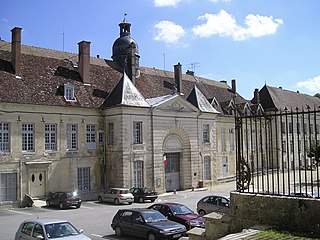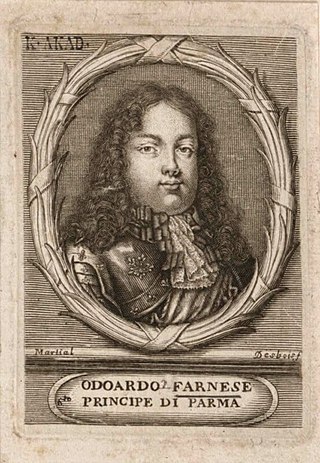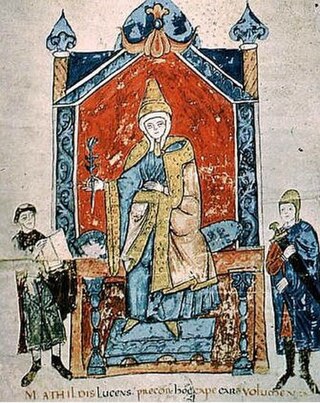Related Research Articles

Benedict of Nursia, often known as Saint Benedict, was an Italian Catholic monk. He is famed in the Catholic Church, the Eastern Orthodox Church, the Lutheran Churches, the Anglican Communion, and Old Catholic Churches. In 1964 Pope Paul VI declared Benedict a patron saint of Europe.

Clairvaux Abbey was a Cistercian monastery in Ville-sous-la-Ferté, 15 kilometres (9.3 mi) from Bar-sur-Aube. The original building, founded in 1115 by Bernard of Clairvaux, is now in ruins; the present structure dates from 1708. Clairvaux Abbey was a good example of the general layout of a Cistercian monastery. The abbey has been listed since 1926 as a historical monument by the French Ministry of Culture.

The Bridgettines, or Birgittines, formally known as the Order of the Most Holy Saviour, is a monastic religious order of the Catholic Church founded by Saint Birgitta in 1344 and approved by Pope Urban V in 1370. They follow the Rule of Saint Augustine. There are today several different branches of Bridgettines.
In Christianity, an oblate is a person who is specifically dedicated to God and to God's service.
Gaudentius of Ossero was bishop of Ossero, on the island of Lussino in the Istrian March from 1030 to 1042. June 1 is his Feast Day.

Berthold of Garsten, O.S.B., also known as Berthold de Rachez, was a German Roman Catholic priest and a monk of the Order of Saint Benedict. He was a noted abbot of a major monastic house in the region, and is revered for the holiness of his life by the Catholic Church.

The Vallombrosians are a monastic religious order in the Catholic Church. They are named after the location of their motherhouse founded in Vallombrosa, situated 30 km from Florence on the northwest slope of Monte Secchieta in the Pratomagno chain. They use the postnominal abbreviation OSBVall to distinguish themselves from other Benedictines, who generally use the abbreviation OSB.

Willibald was an 8th-century bishop of Eichstätt in Bavaria.

Odoardo Farnese was the eldest son of Duke Ranuccio II Farnese, Duke of Parma and Piacenza. Odoardo was the Hereditary Prince of Parma from his birth until his death. He was the father of the famously domineering Elisabeth, Queen of Spain.
Berthold II, also known as Berchtold II, was the Duke of Swabia from 1092 to 1098. After he conceded the Duchy of Swabia to the Staufer in 1098, the title of "Duke of Zähringen" was created for him, in use from c. 1100 and continued by his successors until 1218.
Giovanni Battista Magnani was an Italian architect working entirely in Parma in the first half of the 17th century. He was the most successful of a family of masons and architects that included his father Nicostrato and his son Carlo.

Isidoro Chiari, or IsidoroClario or Isidoroda Chiari, perhaps better known by his Latin name Isidorus Clarius and sometimes called Brixianus after the land of his birth, was a founding father of the Council of Trent and an editor of an edition of the Vulgate.

San Giovanni Evangelista is a Mannerist-style, Roman Catholic church located on Piazzale San Giovanni, located just behind the apse of the Parma Cathedral, in the historic center of Parma, northern Italy. The buildings surrounding the piazza were also part of a former Benedictine convent. The church is notable for its Correggio frescoes.

Sant'Alessandro is a Baroque-style, Roman Catholic church located on in via Garibaldi #14 in central Parma, Italy. The facade of the church faces the church of the Steccata.
The Abbey of San Giusto is a former Cistercian monastery located in the valley of the river Marta approximately 4 km south of Tuscania, Province of Viterbo, Italy.

Donizo of Canossa, was an Italian monk and author in the late eleventh and early twelfth centuries. His work is an important source on Matilda of Tuscany and her dynasty, and also on Gregorian Reform and the Investiture Controversy more generally.

The Camera di San Paolo or Camera della Badessa is a room in the former Monastery of San Paolo, in Parma, northern Italy. It is painted with frescoes by Correggio in the vault (697x645 cm) and over the fireplace.
Domenico Valmagini (1677–1730) was an Italian architect and engineer, active in a Baroque style in the Duchy of Parma and in Lombardy. After the death of Giovanni Battista Barattieri, Domenico was appointed the main court architect for Ranuccio II. In 1695, he was replaced by the brothers Galli Bibiena at the behest of the new Duke Francesco Farnese.

The College of Sant'Anselmo is an international Benedictine college founded by Pope Leo XIII in 1887 and located in Rome, Italy. Situated on the Aventine Hill, it is one of four Benedictine institutions that occupy the complex known as "Sant'Anselmo all'Aventino" which serves as the Primatial Abbey of the Benedictine Confederation. As an ecclesiastical residential college in the Roman College tradition, it serves as both a house of formation for Benedictines, but also as a residence for over one hundred monks from around forty countries, religious, diocesan priests, and lay people. It offers a monastic environment for those who study at the onsite Pontifical Athenaeum of Saint Anselm or at other Roman pontifical universities.
Berthold is a Germanic given name and surname. It is derived from two elements, berht ('bright') and wald. Variants include Berchtold and Bertolt.
References
- ↑ Our Sunday Visitor's Encyclopedia of Saints Matthew Bunson, Stephen Bunson - 2003 - Page 166 "Berthold (d. 1111) Benedictine lay brother.
- ↑ St. Berthold Catholic Online
- ↑ Vita e Miracoli di Bertoldo, Oblato del Monastero delle Monache di Santo Alessandro di Parma Appreffo Giacomo Ardizzoni, Stampator Camer. 1624, Con licenza de Superiori. 1624.